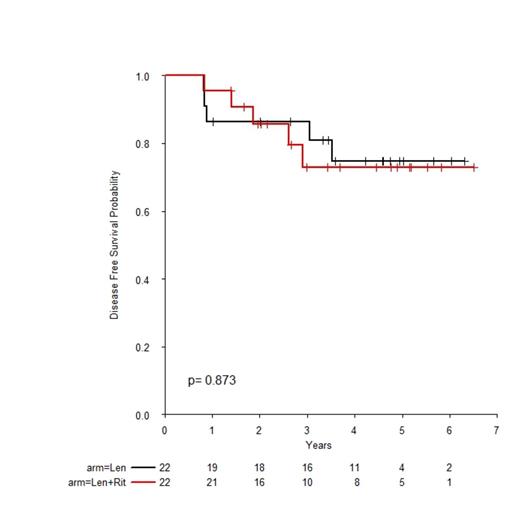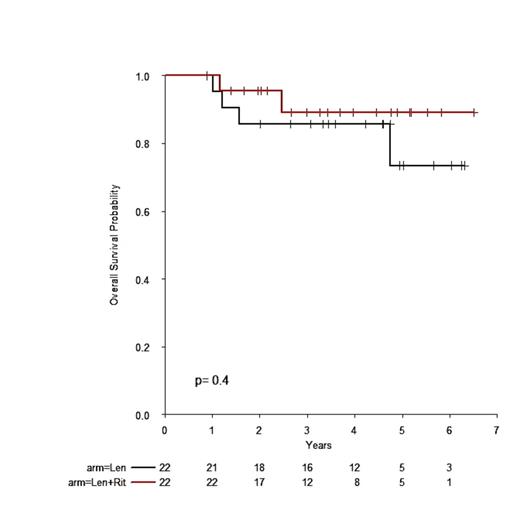Abstract
Background: DLBCLpatients (pts) with an elevated international prognostic index (IPI) score are at an increased risk of disease relapse rate in the first year after completion of standard therapy with rituximab (R) -CHOP. Lenalidomide (len), an immunomodulatory drug, has activity in relapsed DLBCL. Len enhances the natural killer cell mediated antibody-dependent cellular cytotoxicity of rituximab in lymphoma cell lines and inhibits angiogenesis as well as alters cytokine production. Given the activity of len in DLBCL, we explored this combination as a consolidative approach for one year following R-CHOP therapy.
Methods: Intermediate-high/high risk IPI patients with DLBCL were randomized to len (arm A) alone or len and rituximab (arm B). The primary endpoint of the study was to assess the one year disease-free survival (DFS). We expected that a 25% difference of relapse from an expected 40% relapse based on historical controls would have clinical significance when compared with current standard therapy. Patients in arm A received len at a dose of 25 mg daily for 21 days of 28 days. Patients on arm B received len at a dose of 20 mg daily for 21 days of 28 days along with rituximab on day 8 of even cycles. Aspirin was administered to all patients. Treatment on both arms was continued for one year. Treatment was discontinued for disease progression. Len dose adjustments were incorporated in the protocol.
Results: Forty-four pts, 22 arm A/ 22 arm B, 21 female/23 male, with a median age of 59.6 yrs (range 19-85 yrs) were enrolled. The median IPI was 4 for patients over the age of 60 and the median aa-IPI was 3. Three patients received radiation to areas of bulky disease. At a median follow-up of 3.64 years, the two-year DFS and overall survival (OS) was 86% (72%-94%) and 91% (77%-96%), respectively. For patients in arm A and arm B the two-year DFS was 86% (63% - 95%)% vs. 86% ( 62% - 95%)% (figure 1) and the two-year OS was 86% (62% - 95%)% vs. 95% ( 72% - 99%)% (figure 2), respectively (P=NS). Two pts discontinued treatment due to adverse events. The most common grade 3-4 toxicities include neutropenia (57%), fatigue (9%), diarrhea (8%), rash (1%). Related grade 1-2 toxicities include endocrine abnormalities [hypo/hyperthyroidism] (29.5%) and rash (65%).
Conclusions: Len alone as maintenance therapy demonstrates significant clinical activity following standard chemotherapy and improves DFS and OS in DLBCL patients with high-risk prognostic features as compared with historical controls. This trial is registered with NCI- #NCT00765245
Reddy:ImmunoGen: Consultancy; PCYC: Consultancy; Gilead: Other: Speaker; Seattle Genetics: Consultancy; Celgene: Consultancy, Research Funding. Off Label Use: Lenalidomide following R-CHOP. Park:TEVA: Research Funding; Seattle Genetics: Research Funding; Jannsenn: Other: Travel.
Author notes
Asterisk with author names denotes non-ASH members.



This feature is available to Subscribers Only
Sign In or Create an Account Close Modal